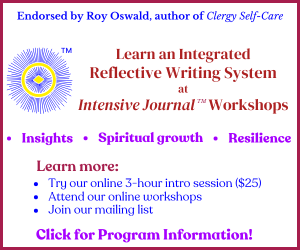Resource Reviews for Continuing Education and Reference January 2020:

The Psychology of Religion: An Empirical Approach, Fifth Edition
Ralph W. Hood, Jr., Peter C. Hill and Bernard Spilka (Boulder, New York: Guilford Press, 2018, 656 pages, hardcover)
In The Psychology of Religion: An Empirical Approach, authors Hood, Hill, and Spilka discuss the foundational difficulty in promoting dialogue between experts in religion and experts in psychology:
Though we now realize that cooperation between religion and the behavioral sciences is essential to human betterment, challenges remain. Probably the most notable challenge is each field’s lack of education and sophisticated knowledge about the other field. Many religious professionals, for example, may not be knowledgeable about psychology, particularly when it comes to distinguishing those psychological claims of a popular variety from those with scientific support. Similarly, many researchers, particularly those who are interested in the religion-health linkage, may be well trained in the field of health and health care, but may have a naïve understanding of religion and spirituality. (461)
These three distinguished professors of psychology take up this challenge, offering a textbook that aims “to present a comprehensive evaluation of the psychology of religion from an empirical perspective … broadly conceived to include any studies in which either quantitative or qualitative data are germane to establishing and/or resolving questions of fact” (viii). They offer an extensive critique of published research which would benefit chaplains and the psychologist colleagues with whom they work on research projects.
Hood, Hill, and Spilka address religion and spirituality, acknowledge the emerging interest in the latter, and include knowledge gleaned from biology/genetics, neuropsychology and sociology. Chaplains will resonate with their recurrent theme–“that the search for meaning is of central importance to human functioning, and that religion is uniquely capable of helping in that search” (17), and “that medical conditions—especially those that are life-threatening—strongly elicit religious attributions which may reduce death anxiety and provide a sense that God is in control” (50). They acknowledge the persistent tension between psychologists who argue that using the natural-scientific method must exclude any reference to transcendence and those who disagree and they suggest a compromise: “Evolutionary psychology’s success in providing a fuller understanding of religion and spirituality as part of the new paradigm will depend upon its openness to a truly interdisciplinary effort, including a willingness to give theology its due” (506).
The authors present fourteen chapters: four that address theoretical foundations; four that span developmental stages (child, adolescent/young adult, adult, and older adult/death); and six that individually focus on conversion, religious groupings, religious/spiritual experiences, mysticism, morality/prejudice and health/psychopathology/coping. Extensive reference, author and subject indexes are included. Each chapter includes Research Boxes citing findings the authors deem significant and concludes with an Overview summary.
The foundational work of William James is frequently referenced. He “distinguished between those ‘once-born,’ who are cultivated within their faith and gradually socialized to accept it unproblematically, and those ‘twice-born,’ with more melancholy temperaments, who are literally compelled through crises to accept or realize their faith within an instant” (223). The authors suggest that “James typifies the psychologist’s propensity to emphasize religious experience in individual terms …” but caution that “James must be revisited in terms of the social and political context of the variety of religions that exist today” (261). Later they point out “James’s insistence that mystical experiences are valid forms of human experience—incapable of being reductionistically explained by either physiological or psychological processes—provided a counter to the emerging natural-scientific possibility that religious experiences may have a truly transcendent dimension” (358).
Gordon Allport’s distinction between Intrinsic and Extrinsic religion is also referenced throughout the text. To the work of Troeltsch, H.R. Niebuhr and Stark, from whom the denomination/sect/cult formulation evolved, they add GATTS (groups that advocate terrorist tactics) and explore whether cults and GATTS should always be perceived as religious.
Hood, Hill, and Spilka cite the contribution of our founding father, Anton Boisen, who
noted that what distinguishes religious experience from otherwise-intense, but pathological, experience is that religious experience is a resolution of what would otherwise be a devastating defeat. For Boisen as for James, it is not the nature of the experience that defines it as religious, but its results. Religious experiences, like some pathological experiences, force a confrontation with great personal disharmony. … A religious experience marks the successful resolution of an inner conflict defined in transcendental terms. (321)
There is much here for parish clergy and chaplains, especially the four chapters discussing the psychological aspects of faith formation through developmental stages and the opportunity to reflect upon patients’ lives along the denomination/sect/cult continuum. They counsel resistance to the “medicalization of deviance,” namely that “conversion to cult beliefs and adherence to cult norms are interpreted as symptoms of illness or pathology…. In opposition to clinical claims are the claims of most empirical researchers, who have found no evidence that cults use methods or techniques in order to alter normal psychological processes” (282).
The chapter that reviews the relationship between religion/spirituality and health, psychopathology and coping, contains encouraging conclusions:
. . . religion functions largely as a means of countering rather than contributing to psychopathology, though severe forms of unhealthy religion will probably have serious psychological and perhaps even physical consequences. In most instances, faith buttresses people’s sense of control and self-esteem, offers meanings that oppose anxiety, provides hope, sanctions socially facilitating behavior, enhances personal well-being and promotes social integration. Probably the most hopeful sign is the increasing recognition by both clinicians and religionists of the potential benefits each group has to contribute. (499)
This text belongs in the libraries of CPE centers and behavioral health care facilities alongside older texts with similar titles by pastoral theologians James Nelson (2009), Wayne Oates (1973) and Paul Pruyser (1968). Also recommended is the monthly on-line Crossroads newsletter from the Center for Spirituality, Theology and Health at Duke University (dukespiritualityandhealth@gmail.com).
Reviewed by Roy F. Olson, DMin, a retired BCC who specialized in behavioral health chaplaincy.

We Make the Road by Walking: A Year-Long Quest for Spiritual Formation, Reorientation, and Activation
Brian D. McLaren (New York: Jericho Books, 2015, 304 pages, softcover, hardcover, Kindle, Audiobook)
McLaren’s book is a devotional work, intended for a general Christian audience of those who would like to deepen their relationship with the Divine, but “[i]t is also a work of public and practical theology—theology that is worked out by ‘normal’ people in daily life” (xii). It assumes that when it comes to spiritual formation, we are all works in progress, making our own road or path as we engage the process. McLaren presents an image of the Holy whose desire is that followers live lives characterized by “aliveness.” He explains, “What we all want is pretty simple, really. We want to be alive. To feel alive. Not just to exist but to thrive, to live out loud, walk tall, breathe free. We want to be less lonely, less exhausted, less conflicted or afraid…more awake, more grateful, more energized and purposeful” (xv).
The book is readable and engaging. It is arranged with a chapter for every week, thirteen chapters per quarter, roughly following the liturgical year. There are additional chapters for Christmas Eve and the triduum. Chapters are short, roughly 5 pages long. They begin with suggested scripture passages followed by discussion and conclude with six questions for reflection. The questions follow a standardized format: one focusing on the reader as new, engaging, or novel; one inviting the reader to tell a related personal story; one engaging children; one inviting action; and one encouraging reflection for the coming week. There are also questions at the conclusion of each quarterly section.
We Make the Road by Walking is intended for both private study or for use in small groups. It concludes with two appendices. The first provides a liturgical form including the eucharist that could be used either in a group setting or in a private devotional setting like the liturgy of the hours. Appendix two offers guidelines for group discussion.
The author presents an excellent resource for those who find the usual daily devotional guides too limited in scope or content. It offers a middle ground between the usual pocket-sized quarterly devotional books and commentary study. It is meaty, but accessible. McLaren understands that his interpretations may be new or different from what readers are used to, advising that “you are asked only to give it an honest and open hearing, and you should feel free to prefer another interpretation” (xiii). McLaren presents an enticing invitation to greater spiritual depth and awareness.
Reviewed by Vicki G. Lumpkin PhD BCC, Chaplain, Hospice of Rockingham County, Reidsville, NC.

